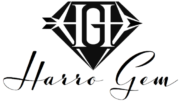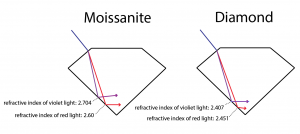The refractive index (RI) of a gemstone is a measurement of its ability to bend light. Moissanite’s refractive index (2.65) is a little higher than diamond (2.42). Both numbers are considered relatively high in the gemstone world, which means both moissanite and diamond will have exceptional sparkle. Why does a high refractive index result in more sparkle? Simply put, a gemstone with a high refractive index has the ability to bend light entering the stone and redirect more light back to your eyes. A gemstone with a low refractive index allows much of the light to pass right through the stone.
Another optical property, dispersion, is also related to the refractive index. Moissanite has a dispersion rating of 0.104, while diamond is only 0.044. As light passes through a gemstone, the red light bends the least, and each subsequent color of the rainbow bends a little more, while violet bends the most. The difference between the refractive indices of red light and violet light is called the dispersion. The stated refractive index of a gemstone is the average of the whole spectrum’s RI.
You can see in the above diagram that the RI of red light for moissanite is 2.60, and the RI of violet light is 2.704. The difference between the two numbers is 0.104, which is the dispersion of moissanite. The superior dispersion of moissanite means that as white light enters the stone, the different colors of the rainbow are separated further apart resulting in different colors reflecting back to your eyes. This is called fire. Diamonds have a lot of fire as well. In fact, the difference in fire between moissanite and diamond is less than what the dispersion numbers would suggest. When comparing moissanite’s dispersion of 0.104 vs. diamond’s 0.044, one would be tempted to say moissanite has over twice the amount of fire as diamond. However, that is not always the case.
Diamond has sufficient dispersion to break up white light into its rainbow colors. Moissanite will separate the colors a little more, but it doesn’t really change the colors that you see. If you are already seeing all the colors of the rainbow with diamond, you will see more or less the same colors with moissanite. One reason why moissanite can appear to have more fire than diamond is because the intensity and frequency of the sparkle can make the different colors more obvious. However, not all sparkles will have color because light that enters straight through the table usually comes back as white light in both moissanite and diamond. Furthermore, light that reflects off a crown facet without entering the stone remains white as well. A colorful display of fire in either stone is only exemplified under intense spot lighting or direct sunlight. Diffused lighting doesn’t result in much fire in diamond or moissanite.
Another factor that can affect fire in diamonds and moissanite is the shape of the stone and how well it is cut. Some diamonds are cut too deep or too shallow to maximize carat weight, avoid inclusions, etc. This results in light leakage, which will greatly reduce sparkle and fire. Moissanite, on the other hand, is lab-created, so it doesn’t need to be cut to avoid inclusions and can be cut to maximize its optical properties. However, certain shapes just aren’t as fiery, such as the pear, princess, marquise, and emerald. It’s worth noting that a brilliant oval moissanite displays significantly more fire than a brilliant oval diamond. More on this phenomenon in our next post…

